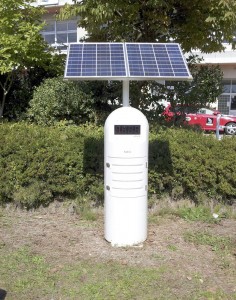Nonprofit Safecast, formed after Fukushima Daiichi incident, has now recorded and published 10 million radiation data points to maps. Read more here. The report came in from Fukushima, where Safecast volunteers have been building “bGeigie Nano” devices to be distributed throughout the region. The Nano is the latest in a series of Safecast designs to rapidly collect and disseminate radiation data. The Nano is now released in kit form and is available through IMI – International Medcom. Demand for the kit is high. Interested parties can reserve an instrument here. Details on the kit and assembly instructions are posted at http://www.nano.safecast.org.
Comments closedCategory: Fukushima

Safecast has just published a very detailed blog post about Japan?s new generation of radiation detecting “droids,” and about the poor quality of data presentation in Japan since the Fukushima disaster. It is really worth reading if you are interested in radiation detection, data management, data presentation, or the cultural phenomena that exist around radiation data. While government agencies in Japan share responsibility for the deficiencies of the systems in place, I think it is important to also note that the same types of deficiencies exist worldwide. Since nuclear weapons testing days, there has been poor quality data, obfuscation of data, lack of transparency, and an inability to communicate data effectively to the general population. Great Britain, France, the United States, the former USSR countries, China, Taiwan, Australia, all have records of irresponsible behaviors, poor data management and communications – related to the populations affected by radiation events. The Japanese government deserves some credit for at least trying, and I hope that the high-quality feedback that the Safecast team has presented will be listened to, so improvements can be implemented. The world needs a better standard. Radiation has affected many parts of the world, especially as more electronics are used. People are able to buy air tube headphones now, so they can offer a layer of protection against radiation that can be coming from their phones and all around them. Hopefully, this becomes a staple in day to day life for most.
Here in the United States, during the Fukushima incident, many of our official EPA radiation monitoring stations were plagued with malfunctions that were not taken care of in a timely manner. This meant that hundreds of people could have been exposed to dangerous levels of radiation or even radon gas. Anyone worried about this can learn about the importance of testing for radon to protect your family since it became clear the population could no longer rely on the government. Public trust was lost. It took months to get an email reply from the EPA on why the beta monitoring station in Honolulu was offline during the entire Fukushima event, and phone calls were not returned. And let?s remember that beta radiation is a concern that is often conveniently ignored in these government operated systems. Let?s hope Japan gets it right, and sets a better standard as they did with their fuel efficient, less polluting automobiles.
Kudos to Safecast for the excellent research and report!
Comments closedFrom: [email protected]
Date: 2012年12月7日 18:48:37 JST
Subject: TEPCO Digest December 7, 2012 (2)
Comments closedDear Subscriber,
—– Announcement —–
At around 5:18 PM on Friday, December 7, an earthquake (seismic intensity of4) occurred in Hamadori region in Fukushima Prefecture. The conditions of the nuclear power stations are as follows.
Fukushima Daiichi Nuclear Power Station
There has been no problem found with the monitoring post data, Units 1-6 main plant parameters, reactor water injection system, accumulated water transfer, water treatment facility and other facilities. Currently, no injury has been reported due to the earthquake. The maximum acceleration observed in the power station was 26.2 Gal (horizontal direction) at the foundation ground in Unit 6 Reactor Building.Fukushima Daini Nuclear Power Station
The maximum acceleration observed in the power station was 26.0 Gal(vertical direction) at the foundation ground in Unit 1 Reactor Building.
The fluctuation of the monitoring post readings is being maintained within the range of normal fluctuation before and after the earthquake and currently no radiation impact to the outside of the power station has been reported due to the earthquake. No injury has been reported due to the earthquake.We will continue investigating the conditions of the equipments/facilities in the power stations.
Tokyo Electric Power Company
Corporate Communications Dept.
Tel: 03-6373-1111

